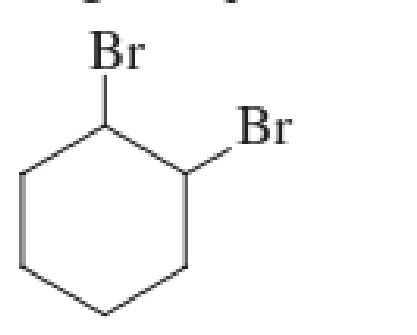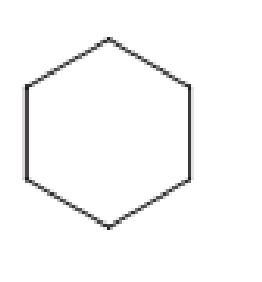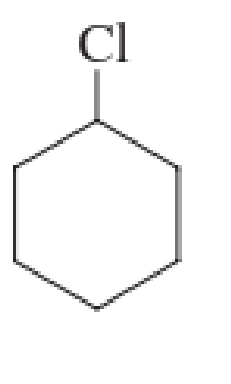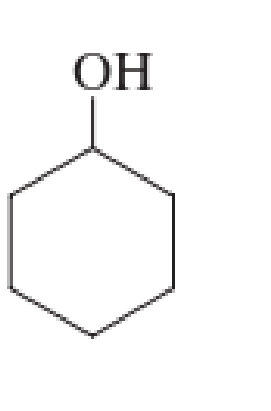
Study Guide with Selected Solutions for Stoker's General, Organic, and Biological Chemistry, 7th
7th Edition
ISBN: 9781305081086
Author: STOKER, H. Stephen
Publisher: Brooks Cole
expand_more
expand_more
format_list_bulleted
Concept explainers
Textbook Question
Chapter 13, Problem 13.79EP
What reactant would you use to prepare each of the following compounds from cyclohexene?




Expert Solution & Answer
Trending nowThis is a popular solution!

Students have asked these similar questions
None
3. Consider the compounds below and determine if they are aromatic, antiaromatic, or
non-aromatic. In case of aromatic or anti-aromatic, please indicate number of I
electrons in the respective systems. (Hint: 1. Not all lone pair electrons were explicitly
drawn and you should be able to tell that the bonding electrons and lone pair electrons
should reside in which hybridized atomic orbital 2. You should consider ring strain-
flexibility and steric repulsion that facilitates adoption of aromaticity or avoidance of anti-
aromaticity)
H H
N
N:
NH2
N
Aromaticity
(Circle)
Aromatic Aromatic Aromatic Aromatic Aromatic
Antiaromatic Antiaromatic Antiaromatic Antiaromatic Antiaromatic
nonaromatic nonaromatic nonaromatic nonaromatic nonaromatic
aromatic TT
electrons
Me
H
Me
Aromaticity
(Circle)
Aromatic Aromatic Aromatic
Aromatic Aromatic
Antiaromatic Antiaromatic Antiaromatic Antiaromatic Antiaromatic
nonaromatic nonaromatic nonaromatic nonaromatic nonaromatic
aromatic πT
electrons
H
HH…
A chemistry graduate student is studying the rate of this reaction:
2 HI (g) →H2(g) +12(g)
She fills a reaction vessel with HI and measures its concentration as the reaction proceeds:
time
(minutes)
[IH]
0
0.800M
1.0
0.301 M
2.0
0.185 M
3.0
0.134M
4.0
0.105 M
Use this data to answer the following questions.
Write the rate law for this reaction.
rate
= 0
Calculate the value of the rate constant k.
k =
Round your answer to 2 significant digits. Also be
sure your answer has the correct unit symbol.
Chapter 13 Solutions
Study Guide with Selected Solutions for Stoker's General, Organic, and Biological Chemistry, 7th
Ch. 13.1 - Prob. 1QQCh. 13.1 - Prob. 2QQCh. 13.1 - Prob. 3QQCh. 13.2 - Prob. 1QQCh. 13.2 - Prob. 2QQCh. 13.2 - Prob. 3QQCh. 13.2 - Prob. 4QQCh. 13.3 - Prob. 1QQCh. 13.3 - Prob. 2QQCh. 13.3 - Prob. 3QQ
Ch. 13.3 - Prob. 4QQCh. 13.4 - Prob. 1QQCh. 13.4 - Prob. 2QQCh. 13.5 - Prob. 1QQCh. 13.5 - Prob. 2QQCh. 13.5 - Prob. 3QQCh. 13.6 - Prob. 1QQCh. 13.6 - Prob. 2QQCh. 13.6 - Prob. 3QQCh. 13.7 - Prob. 1QQCh. 13.7 - Prob. 2QQCh. 13.7 - Prob. 3QQCh. 13.8 - Prob. 1QQCh. 13.8 - Prob. 2QQCh. 13.9 - Prob. 1QQCh. 13.9 - Prob. 2QQCh. 13.10 - Prob. 1QQCh. 13.10 - Prob. 2QQCh. 13.10 - Prob. 3QQCh. 13.10 - Prob. 4QQCh. 13.10 - Prob. 5QQCh. 13.11 - Prob. 1QQCh. 13.11 - Prob. 2QQCh. 13.11 - Prob. 3QQCh. 13.11 - Prob. 4QQCh. 13.11 - Prob. 5QQCh. 13.12 - Prob. 1QQCh. 13.12 - Prob. 2QQCh. 13.12 - Prob. 3QQCh. 13.12 - Prob. 4QQCh. 13.12 - Prob. 5QQCh. 13.13 - Prob. 1QQCh. 13.13 - Prob. 2QQCh. 13.13 - Prob. 3QQCh. 13.14 - Prob. 1QQCh. 13.14 - Prob. 2QQCh. 13.14 - Prob. 3QQCh. 13.14 - Prob. 4QQCh. 13.15 - Prob. 1QQCh. 13.15 - Prob. 2QQCh. 13.15 - Prob. 3QQCh. 13.15 - Prob. 4QQCh. 13.16 - Prob. 1QQCh. 13.16 - Prob. 2QQCh. 13 - Classify each of the following hydrocarbons as...Ch. 13 - Classify each of the following hydrocarbons as...Ch. 13 - Prob. 13.3EPCh. 13 - Prob. 13.4EPCh. 13 - Prob. 13.5EPCh. 13 - Prob. 13.6EPCh. 13 - Prob. 13.7EPCh. 13 - Prob. 13.8EPCh. 13 - Prob. 13.9EPCh. 13 - What is the molecular formula for each of the...Ch. 13 - Prob. 13.11EPCh. 13 - Prob. 13.12EPCh. 13 - What is wrong, if anything, with the following...Ch. 13 - Prob. 13.14EPCh. 13 - Prob. 13.15EPCh. 13 - Prob. 13.16EPCh. 13 - Prob. 13.17EPCh. 13 - Prob. 13.18EPCh. 13 - Draw a condensed structural formula for each of...Ch. 13 - Draw a condensed structural formula for each of...Ch. 13 - The following names are incorrect by IUPAC rules....Ch. 13 - The following names are incorrect by IUPAC rules....Ch. 13 - Prob. 13.23EPCh. 13 - Prob. 13.24EPCh. 13 - Prob. 13.25EPCh. 13 - Classify each of the following compounds as...Ch. 13 - Prob. 13.27EPCh. 13 - How many hydrogen atoms are present in a molecule...Ch. 13 - Prob. 13.29EPCh. 13 - Draw a line-angle structural formula for each of...Ch. 13 - Prob. 13.31EPCh. 13 - Prob. 13.32EPCh. 13 - Prob. 13.33EPCh. 13 - Prob. 13.34EPCh. 13 - Prob. 13.35EPCh. 13 - Prob. 13.36EPCh. 13 - Prob. 13.37EPCh. 13 - Prob. 13.38EPCh. 13 - For each of the following pairs of alkenes,...Ch. 13 - Prob. 13.40EPCh. 13 - Prob. 13.41EPCh. 13 - Prob. 13.42EPCh. 13 - Prob. 13.43EPCh. 13 - Prob. 13.44EPCh. 13 - Prob. 13.45EPCh. 13 - Prob. 13.46EPCh. 13 - For each molecule, indicate whether cistrans...Ch. 13 - For each molecule, indicate whether cistrans...Ch. 13 - Prob. 13.49EPCh. 13 - Prob. 13.50EPCh. 13 - Prob. 13.51EPCh. 13 - Draw a structural formula for each of the...Ch. 13 - Prob. 13.53EPCh. 13 - Prob. 13.54EPCh. 13 - Prob. 13.55EPCh. 13 - Prob. 13.56EPCh. 13 - Prob. 13.57EPCh. 13 - Prob. 13.58EPCh. 13 - Why is the number of carbon atoms in a terpene...Ch. 13 - How many isoprene units are present in a....Ch. 13 - Prob. 13.61EPCh. 13 - Indicate whether each of the following statements...Ch. 13 - Prob. 13.63EPCh. 13 - With the help of Figure 13-7, indicate whether...Ch. 13 - Prob. 13.65EPCh. 13 - Prob. 13.66EPCh. 13 - Prob. 13.67EPCh. 13 - Prob. 13.68EPCh. 13 - Prob. 13.69EPCh. 13 - Prob. 13.70EPCh. 13 - Prob. 13.71EPCh. 13 - Prob. 13.72EPCh. 13 - Prob. 13.73EPCh. 13 - Prob. 13.74EPCh. 13 - Prob. 13.75EPCh. 13 - Write a chemical equation showing reactants,...Ch. 13 - Supply the structural formula of the product in...Ch. 13 - Prob. 13.78EPCh. 13 - What reactant would you use to prepare each of the...Ch. 13 - Prob. 13.80EPCh. 13 - Prob. 13.81EPCh. 13 - Prob. 13.82EPCh. 13 - Prob. 13.83EPCh. 13 - Prob. 13.84EPCh. 13 - Prob. 13.85EPCh. 13 - Prob. 13.86EPCh. 13 - Prob. 13.87EPCh. 13 - Prob. 13.88EPCh. 13 - Prob. 13.89EPCh. 13 - Prob. 13.90EPCh. 13 - Prob. 13.91EPCh. 13 - Prob. 13.92EPCh. 13 - Prob. 13.93EPCh. 13 - What are the bond angles about the triple bond in...Ch. 13 - Prob. 13.95EPCh. 13 - Prob. 13.96EPCh. 13 - Prob. 13.97EPCh. 13 - Prob. 13.98EPCh. 13 - Prob. 13.99EPCh. 13 - Prob. 13.100EPCh. 13 - Prob. 13.101EPCh. 13 - Prob. 13.102EPCh. 13 - Prob. 13.103EPCh. 13 - Prob. 13.104EPCh. 13 - Prob. 13.105EPCh. 13 - Prob. 13.106EPCh. 13 - Prob. 13.107EPCh. 13 - Prob. 13.108EPCh. 13 - Assign each of the compounds in Problem 13-107 an...Ch. 13 - Assign each of the compounds in Problem 13-108 an...Ch. 13 - Prob. 13.111EPCh. 13 - Prob. 13.112EPCh. 13 - Prob. 13.113EPCh. 13 - Prob. 13.114EPCh. 13 - Prob. 13.115EPCh. 13 - Write a structural formula for each of the...Ch. 13 - Eight isomeric substituted benzenes have the...Ch. 13 - Prob. 13.118EPCh. 13 - Prob. 13.119EPCh. 13 - Prob. 13.120EPCh. 13 - Prob. 13.121EPCh. 13 - Prob. 13.122EPCh. 13 - Prob. 13.123EPCh. 13 - Prob. 13.124EPCh. 13 - Prob. 13.125EPCh. 13 - For each of the following classes of compounds,...Ch. 13 - Prob. 13.127EPCh. 13 - Prob. 13.128EPCh. 13 - Prob. 13.129EPCh. 13 - Prob. 13.130EP
Knowledge Booster
Learn more about
Need a deep-dive on the concept behind this application? Look no further. Learn more about this topic, chemistry and related others by exploring similar questions and additional content below.Similar questions
- 1. For the four structures provided, Please answer the following questions in the table below. a. Please draw π molecular orbital diagram (use the polygon-and-circle method if appropriate) and fill electrons in each molecular orbital b. Please indicate the number of π electrons c. Please indicate if each molecule provided is anti-aromatic, aromatic, or non- aromatic TT MO diagram Number of π e- Aromaticity Evaluation (X choose one) Non-aromatic Aromatic Anti-aromatic || ||| + IVarrow_forward1.3 grams of pottasium iodide is placed in 100 mL of o.11 mol/L lead nitrate solution. At room temperature, lead iodide has a Ksp of 4.4x10^-9. How many moles of precipitate will form?arrow_forwardQ3: Circle the molecules that are optically active: ДДДДarrow_forward
- 6. How many peaks would be observed for each of the circled protons in the compounds below? 8 pts CH3 CH3 ΤΙ A. H3C-C-C-CH3 I (₁₁ +1)= 7 H CI B. H3C-C-CI H (3+1)=4 H LIH)=2 C. (CH3CH2-C-OH H D. CH3arrow_forwardNonearrow_forwardQ1: Draw the most stable and the least stable Newman projections about the C2-C3 bond for each of the following isomers (A-C). Are the barriers to rotation identical for enantiomers A and B? How about the diastereomers (A versus C or B versus C)? H Br H Br (S) CH3 (R) CH3 H3C (S) H3C H Br Br H A C enantiomers H Br H Br (R) CH3 H3C (R) (S) CH3 H3C H Br Br H B D identicalarrow_forward
arrow_back_ios
SEE MORE QUESTIONS
arrow_forward_ios
Recommended textbooks for you
 Organic And Biological ChemistryChemistryISBN:9781305081079Author:STOKER, H. Stephen (howard Stephen)Publisher:Cengage Learning,
Organic And Biological ChemistryChemistryISBN:9781305081079Author:STOKER, H. Stephen (howard Stephen)Publisher:Cengage Learning, General, Organic, and Biological ChemistryChemistryISBN:9781285853918Author:H. Stephen StokerPublisher:Cengage Learning
General, Organic, and Biological ChemistryChemistryISBN:9781285853918Author:H. Stephen StokerPublisher:Cengage Learning Chemistry: Principles and PracticeChemistryISBN:9780534420123Author:Daniel L. Reger, Scott R. Goode, David W. Ball, Edward MercerPublisher:Cengage Learning
Chemistry: Principles and PracticeChemistryISBN:9780534420123Author:Daniel L. Reger, Scott R. Goode, David W. Ball, Edward MercerPublisher:Cengage Learning Chemistry: Principles and ReactionsChemistryISBN:9781305079373Author:William L. Masterton, Cecile N. HurleyPublisher:Cengage Learning
Chemistry: Principles and ReactionsChemistryISBN:9781305079373Author:William L. Masterton, Cecile N. HurleyPublisher:Cengage Learning Introduction to General, Organic and BiochemistryChemistryISBN:9781285869759Author:Frederick A. Bettelheim, William H. Brown, Mary K. Campbell, Shawn O. Farrell, Omar TorresPublisher:Cengage Learning
Introduction to General, Organic and BiochemistryChemistryISBN:9781285869759Author:Frederick A. Bettelheim, William H. Brown, Mary K. Campbell, Shawn O. Farrell, Omar TorresPublisher:Cengage Learning

Organic And Biological Chemistry
Chemistry
ISBN:9781305081079
Author:STOKER, H. Stephen (howard Stephen)
Publisher:Cengage Learning,

General, Organic, and Biological Chemistry
Chemistry
ISBN:9781285853918
Author:H. Stephen Stoker
Publisher:Cengage Learning

Chemistry: Principles and Practice
Chemistry
ISBN:9780534420123
Author:Daniel L. Reger, Scott R. Goode, David W. Ball, Edward Mercer
Publisher:Cengage Learning

Chemistry: Principles and Reactions
Chemistry
ISBN:9781305079373
Author:William L. Masterton, Cecile N. Hurley
Publisher:Cengage Learning

Introduction to General, Organic and Biochemistry
Chemistry
ISBN:9781285869759
Author:Frederick A. Bettelheim, William H. Brown, Mary K. Campbell, Shawn O. Farrell, Omar Torres
Publisher:Cengage Learning
Chapter 4 Alkanes and Cycloalkanes Lesson 2; Author: Linda Hanson;https://www.youtube.com/watch?v=AL_CM_Btef4;License: Standard YouTube License, CC-BY
Chapter 4 Alkanes and Cycloalkanes Lesson 1; Author: Linda Hanson;https://www.youtube.com/watch?v=PPIa6EHJMJw;License: Standard Youtube License